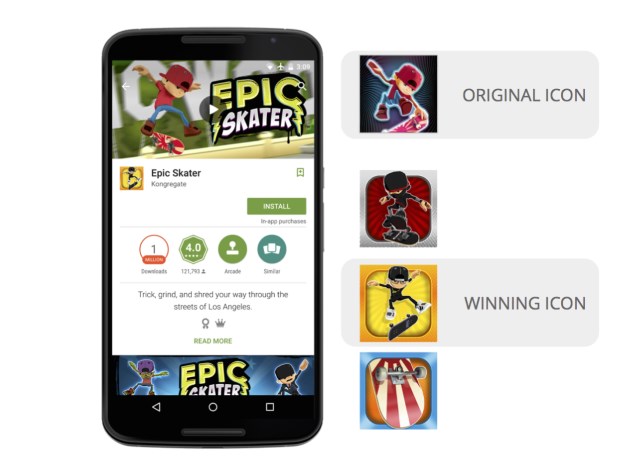- Home
- Mobiles
- Mobiles News
- Google Announces A/B Testing for Play Store Listings; Improved Developer Pages
Google Announces A/B Testing for Play Store Listings; Improved Developer Pages

Google will now allow 'Experiments' from the developer console, which let developers choose up to three alternative sets of graphics and text descriptions for their app listings. These alternative listings will be shown to some visitors, and statistics about engagement and installs will be shown to developers so that they can determine which version of the listing was most appealing and effective, thereby optimising potential. According to Google, some developers achieved double-digit install rate improvements in a pilot program conducted prior to the announcement.
(Also see: Google Play Gets Family Sections; Saw 50 Billion App Installs in a Year)
Developer pages are also to be overhauled with a large banner graphic, company logo, descriptive text and improved catalogue display. Companies will also be able to feature one app or update prominently on their page to drive traffic. Those with lots of apps in the Play Store will benefit the most, and will be able to use their developer page as a homepage to promote all offerings in one place.
(Also see: Android M: Top New Features in the Next Major Android Release)
Google stated that it intends to make developer homepages more prominent and easier to find. One way to do this will be the creation of sections based on broad interests such as shopping, with subsections such as coupon apps and fashion apps. These will appear in search results to increase the chances of users discovering new and unfamiliar apps that suit their requirements.
(Also see: Google Maps to Get New Offline Search, Turn-by-Turn Navigation Features)
There will also be a new easy way for people to discover family-friendly apps and content. A new star icon will lead users to a section highlighting apps approved for the Designed for Families program, sorted by suitable age ranges.
To further boost user acquisition, developers will be able to create and roll out ad campaigns right from the developer console. Only a budget needs to be set, after which Google will scale the campaign out across all its properties including Google Search, AdMob, YouTube and new Google Play search ads.
(Also see: Android M's Google 'Now on Tap' Will Provide Contextual Info Within Apps on Demand)
Developers will also be able to submit apps for testing across a wide variety of actual Android devices that they otherwise would not have access to. Given the fragmentation in terms of screen size, resolution, CPU power and OS version, developers would be able to identify and fix real-world issues that would otherwise not be identified till someone encountered them and complained.
Catch the latest from the Consumer Electronics Show on Gadgets 360, at our CES 2026 hub.
Related Stories
- Samsung Galaxy Unpacked 2025
- ChatGPT
- Redmi Note 14 Pro+
- iPhone 16
- Apple Vision Pro
- Oneplus 12
- OnePlus Nord CE 3 Lite 5G
- iPhone 13
- Xiaomi 14 Pro
- Oppo Find N3
- Tecno Spark Go (2023)
- Realme V30
- Best Phones Under 25000
- Samsung Galaxy S24 Series
- Cryptocurrency
- iQoo 12
- Samsung Galaxy S24 Ultra
- Giottus
- Samsung Galaxy Z Flip 5
- Apple 'Scary Fast'
- Housefull 5
- GoPro Hero 12 Black Review
- Invincible Season 2
- JioGlass
- HD Ready TV
- Laptop Under 50000
- Smartwatch Under 10000
- Latest Mobile Phones
- Compare Phones
- OPPO Reno 15 Pro Max
- Honor Win RT
- Honor Win
- Xiaomi 17 Ultra Leica Edition
- Xiaomi 17 Ultra
- Huawei Nova 15
- Huawei Nova 15 Pro
- Huawei Nova 15 Ultra
- Asus ProArt P16
- MacBook Pro 14-inch (M5, 2025)
- OPPO Pad Air 5
- Huawei MatePad 11.5 (2026)
- Xiaomi Watch 5
- Huawei Watch 10th Anniversary Edition
- Acerpure Nitro Z Series 100-inch QLED TV
- Samsung 43 Inch LED Ultra HD (4K) Smart TV (UA43UE81AFULXL)
- Asus ROG Ally
- Nintendo Switch Lite
- Haier 1.6 Ton 5 Star Inverter Split AC (HSU19G-MZAID5BN-INV)
- Haier 1.6 Ton 5 Star Inverter Split AC (HSU19G-MZAIM5BN-INV)

















